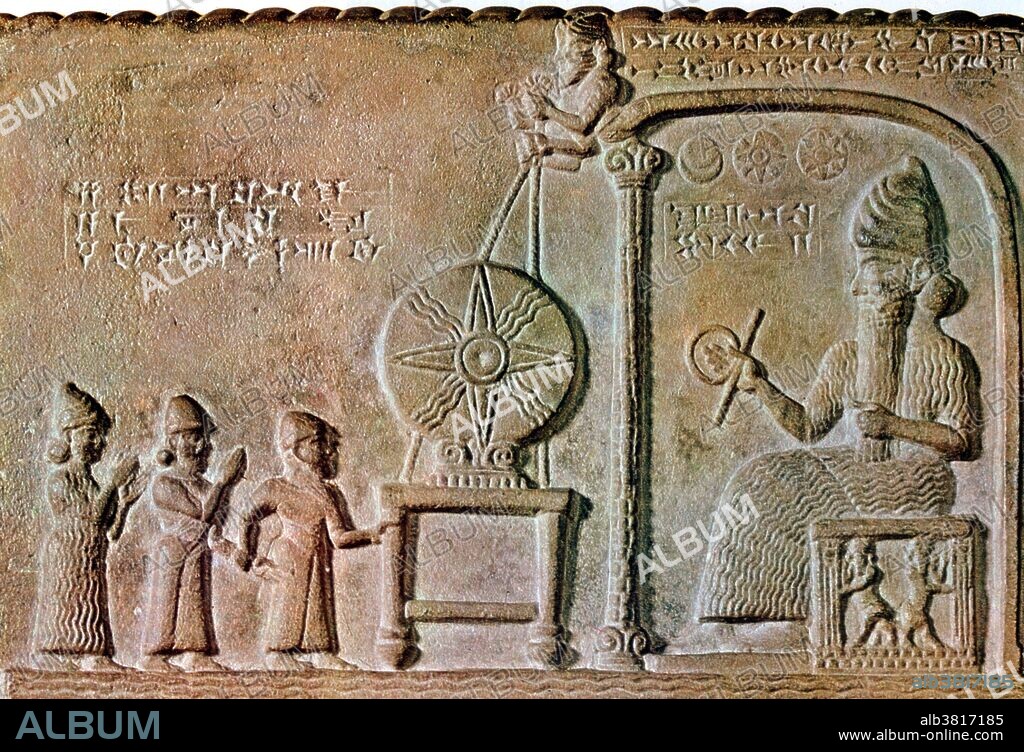alb3817185
Tablet of Shamash, 9th Century BC

|
Añadir a otro lightbox |
|
Añadir a otro lightbox |



¿Ya tienes cuenta? Iniciar sesión
¿No tienes cuenta? Regístrate
Compra esta imagen

Título:
Tablet of Shamash, 9th Century BC
Descripción:
Traducción automática: La Tabla de Shamash es una tableta de piedra recuperada de la antigua ciudad babilónica de Sippar, en el sur de Irak, en 1881. Está fechada en el reinado del rey Nabu-apla-iddina, alrededor del 888-855 a.C. El bajorrelieve en la parte superior del anverso muestra a Shamash, el Dios Sol, debajo de los símbolos del Sol, la Luna y Venus. Se le representa sentado en un santuario, sosteniendo una vara de medir y un carrete de cuerda. Frente a él hay otro gran disco solar sobre un altar, suspendido desde arriba por dos figuras. De las otras tres figuras de la izquierda, la central está vestida de la misma manera que Shamash y se supone que es el rey babilónico Nabu-apla-iddina recibiendo los símbolos de la deidad. El texto cuneiforme debajo de la estela está dividido en quince pasajes, combinando prosa, elementos poéticos y retóricos en la forma típica de las inscripciones reales mesopotámicas. Cuenta cómo Sippar y el templo Ebabbar de Shamash habían caído en mal estado con la pérdida de la estatua del Dios. Esta imagen de culto es reemplazada temporalmente por el disco solar; Se describe además cómo se encontró una nueva figura de Shamash en la parte oriental del Éufrates, a partir de la cual Nabu-apla-iddina ha construido una nueva estatua de lapislázuli y oro para restaurar el culto.
The Tablet of Shamash is a stone tablet recovered from the ancient Babylonian city of Sippar in southern Iraq in 1881. It is dated to the reign of King Nabu-apla-iddina circa 888-855 BC. The bas-relief on the top of the obverse shows Shamash, the Sun God, beneath symbols of the Sun, Moon and Venus. He is depicted in a seated position in a shrine, holding forward a measuring rod and reel of cord. There is another large sun disk in front of him on an altar, suspended from above by two figures. Of the three other figures on the left, the central one is dressed in the same fashion as Shamash and is assumed to be the Babylonian king Nabu-apla-iddina receiving the symbols of deity. The cuneiform text beneath the stele is divided into fifteen passages, blending prose, poetic and rhetorical elements in the fashion typical of Mesopotamian royal inscriptions. It tells how Sippar and the Ebabbar temple of Shamash had fallen into disrepair with the loss of the statue of the God. This cult image is temporarily replaced with the solar disk; it is further described how a new figure of Shamash was found in an eastern part of the Euphrates, from which Nabu-apla-iddina has constructed a new statue of lapis lazuli and gold to restore the cult.
Personas:
Crédito:
Album / Science Source / New York Public Library
Autorizaciones:
Modelo: No - Propiedad: No
¿Preguntas relacionadas con los derechos?
¿Preguntas relacionadas con los derechos?
Tamaño imagen:
4200 x 2866 px | 34.4 MB
Tamaño impresión:
35.6 x 24.3 cm | 14.0 x 9.6 in (300 dpi)
Palabras clave:
ACADIO • ANTIGUO • ANTIGÜEDAD • ARQUEOLOGIA • ARQUEOLÓGICA • ARQUEOLOGICO • ARTE • ARTEFACTO • ASIRIA • ASSYRIAN • BAJO RELIEVE • CIVILIZACION ANTIGUA • CULTURA ANTIGUA • DEIDAD • DIOS DE LA JUSTICIA • DIOS DEL SOL • DIOS • ESCULTURA • HISTORIA • HISTORICO • MESOPOTAMIAN • OBRA DE ARTE • RELIEVE • RELIGION • RELIGIOSO • SISTEMA ESCRITURA • TEXTO
 Pinterest
Pinterest Twitter
Twitter Facebook
Facebook Copiar enlace
Copiar enlace Email
Email
